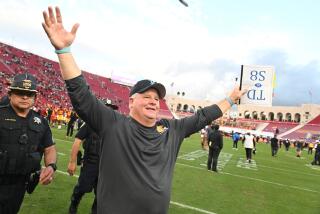Al Saunders becomes the Raiders’ air traffic controller
- Share via
Reporting From Napa, Calif. — The Oakland Raiders were the NFL’s second-ranked running team last season, yet were 23rd when it came to throwing the ball.
Not to worry.
Al will address that.
That’s Al Saunders, not Raiders owner Al Davis.
Saunders, who oversaw some of the more successful passing offenses in NFL history, was hired this year as Oakland’s offensive coordinator, filling the job vacancy created when Hue Jackson was promoted to head coach.
It was a move that brought Saunders’ career full circle, seeing as the 64-year-old coach once worked as a Raiders ball boy and twice interviewed with Davis for the job as head coach.
“It was the right time in my career to be part of this organization,” said Saunders, who worked with Jackson in Baltimore in 2009, and before that in Washington with Jason Campbell, now quarterback of the Raiders.
Saunders had a 17-22 record as coach of the San Diego Chargers from 1986 to 1988 — the man who took over when Don Coryell stepped down — but his credentials as an offensive assistant were polished to a high-gloss shine. He was the receivers coach in St. Louis when the Rams were the “greatest show on turf,” collecting a Super Bowl ring for his efforts. Later, he followed Coach Dick Vermeil to Kansas City, where Saunders was offensive coordinator for a unit that led the NFL with an average of 380.9 yards per game from 2001 to 2005.
With the Redskins in 2006-07, Saunders got to know Campbell, the first-round pick from Auburn who had to familiarize himself with the coach’s 700-page playbook.
“It was,” Campbell recalled, “like Webster’s Dictionary.”
Saunders still lugs that massive tome from team to team, although he knows nobody will use it in its entirety.
Jackson, for instance, who will be calling the plays for the Raiders, said he has done some heavy-duty editing in that Yellow Pages-thick playbook.
“I can’t handle 700 pages,” Jackson said, laughing. “My mind can’t think of all that stuff. I’ve got to keep it simple for myself and my players. We’re putting together the 2011 Raiders offense.
“I say [pretending to flip through a playbook], ‘We’ll take this, won’t take that. We’ll do this, won’t do that.’ Sometimes you just strike it off and say, ‘No.’ … I think we’re now getting to the point where there’s a language that Al, I and the staff speak. The players are learning that.”
Still, the Raiders have their hands full with challenges. They have a slew of injuries to the receiving corps, something that will be readily apparent in Saturday’s exhibition game against San Francisco, and the improvements to the passing game are not going to be instant.
Saunders also has the challenge of squeezing production out of third-year receiver Darrius Heyward-Bey, the No. 7 pick in 2009 who so far has been a major disappointment.
While saying Heyward-Bey has “unlimited” potential, Saunders said one mistake the receiver makes is jumping when the ball is thrown to him, whether he needs to or not, thereby slightly altering his sight lines.
“Part of our job as coaches is to make sure we do things with him so he keeps his feet on the ground and can catch the ball on an even keel all the time,” Saunders said.
He said Campbell needs to find stability in a different sense, to get comfortable with one offense — a scheme he knows from their days together in Washington — and catch his breath after a revolving door of coaches who have come in and out of his career.
“Now he’s learning one technique one year, and then all of a sudden a new language and another technique another year and it’s really hard in times of stress to fall back on a basic concept of doing everything,” Saunders said.
“So the thing that’s kind of curtailed what he probably can be ultimately as a quarterback — if he was in one system ever since he came in the National Football League, with one coordinator and one position coach — he would be far, far more developed than he is now.”
There’s no changing the past, of course. Saunders does think he can have an impact on the club’s future, though.
“When you get to the tail end of your career, there are a lot of things more important in what you do than some other things,” he said. “And I would love to see this franchise return to the way it was when I was a kid growing up.
“I’d like to help the guy that I was a ball boy for years ago maybe return this franchise to the class and the quality that it was many years ago.”
twitter.com/latimesfarmer
More to Read
Go beyond the scoreboard
Get the latest on L.A.'s teams in the daily Sports Report newsletter.
You may occasionally receive promotional content from the Los Angeles Times.











